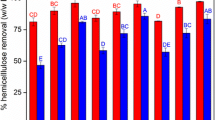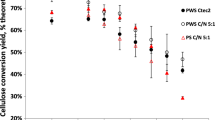Abstract
Processing of lignocellulosic biomass is complex due to the heterogeneity of the substrate, but also due to lengthy unit operations, which complicates process control including for enzymatic saccharification. Methods for predicting enzymatic saccharification yield based on the properties of the pretreated biomass would be advantageous to process optimization and control. Biomass-water interaction measurements provide a method for quickly predicting biomass recalcitrance. Correlating water retention value (WRV) and enzymatic saccharification yield (ESY) on pretreated biomass has shown promise, especially when assessing only single biomass types pretreated with one specific chemistry. However, with comparisons between different types of biomasses, predictive powers have been low. We investigate the effect of pretreatment chemistry on the predictive power of WRV, when keeping the biomass static. Wheat straw was pretreated with dilute acid, hydrothermal, or alkaline chemistries at five different temperatures. Furthermore, low field nuclear magnetic resonance was used to measure water constraint in the pretreated materials, to better understand how biomass-water interactions change with pretreatment severity and chemistry. We show that the correlation of WRV and ESY is highly pretreatment dependent, while WRV strongly predicts ESY within each pretreatment chemistry. While ESY and WRV correlated under all chemistries, the direction of the correlations were divergent, suggesting a more complex interplay between recalcitrance and biomass-water interactions. Using T2 relaxation profiles, reductions in hemicellulose composition was related to the decrease in size of the most constrained water population present in the pretreated biomasses for all chemistries, suggesting a new identification of this population of constrained water.








Similar content being viewed by others
Abbreviations
- DA:
-
Dilute acid pretreatment
- WRV:
-
Water retention value
- AL:
-
Alkaline pretreatment
- HT:
-
Hydrothermal pretreatment
- ESY:
-
Enzymatic saccharification yield
- T2 :
-
Spin–spin relaxation time
- LF-NMR:
-
Low field nuclear magnetic resonance
- ANN:
-
Artificial neural network
- PCA:
-
Principal component analysis
- NIR:
-
Near infrared spectroscopy
- FTIR:
-
Fourier transform infrared spectroscopy
- AFEX:
-
Ammonia fiber explosion pretreatment
- ASE:
-
Accelerated solvent extractor
- DM:
-
Dry matter
References
Al-Rudainy B, Galbe M, Arcos Hernandez M, Jannasch P, Wallberg O (2018) Impact of lignin content on the properties of hemicellulose hydrogels. Polymers. https://doi.org/10.3390/polym11010035
Ambye-Jensen M, Thomsen ST, Kádár Z, Meyer AS (2013) Ensiling of wheat straw decreases the required temperature in hydrothermal pretreatment. Biotechnol Biofuels. https://doi.org/10.1186/1754-6834-6-116
Baum A, Agger J, Meyer AS, Egebo M, Mikkelsen JD (2012) Rapid near infrared spectroscopy for prediction of enzymatic hydrolysis of corn bran after various pretreatments. N Biotechnol 29:293–301. https://doi.org/10.1016/j.nbt.2011.11.010
Bekiaris G, Lindedam J, Peltre C, Decker SR, Turner GB, Magid J, Bruun S (2015) Rapid estimation of sugar release from winter wheat straw during bioethanol production using FTIR-photoacoustic spectroscopy. Biotechnol Biofuels. https://doi.org/10.1186/s13068-015-0267-2
Crowe JD, Zarger RA, Hodge DB (2017) Relating nanoscale accessibility within plant cell walls to improved enzyme hydrolysis yields in corn stover subjected to diverse pretreatments. J Agric Food Chem 65:8652–8662. https://doi.org/10.1021/acs.jafc.7b03240
Fredriksson M, Thygesen LG (2017) The states of water in Norway spruce (Picea abies (L.) Karst.) studied by low-field nuclear magnetic resonance (LFNMR) relaxometry: assignment of free-water populations based on quantitative wood anatomy. Holzforschung 71:77–90. https://doi.org/10.1515/hf-2016-0044
Ghose TK (1987) Measurement of cellulase activities. Pure Appl Chem 59:257–268. https://doi.org/10.1351/pac198759020257
Gollapalli LE, Dale BE, Rivers DM (2002) Predicting digestibility of ammonia fiber explosion (AFEX)-treated rice straw. Appl Biochem Biotechnol-Part A Enzym Eng Biotechnol 98–100:23–35. https://doi.org/10.1385/ABAB:98-100:1-9:23
Gong C, Thomsen ST, Thygesen LG, Felby C (2019) Effects of preheating on briquetting and subsequent hydrothermal pretreatment for enzymatic saccharification of wheat straw. Biotechnol Prog. https://doi.org/10.1002/btpr.2808
Hu F, Ragauskas A (2012) Pretreatment and lignocellulosic chemistry. Bioenergy Res 5:1043–1066. https://doi.org/10.1007/s12155-012-9208-0
Jaisamut K, Paulová L, Patáková P, Rychtera M, Melzoch K (2013) Optimization of alkali pretreatment of wheat straw to be used as substrate for biofuels production. Plant Soil Environ 59:537–542
Jiang J, Wang J, Zhang X, Wolcott M (2016) Evaluation of physical structural features on influencing enzymatic hydrolysis efficiency of micronized wood. RSC Adv 6:103026–103034. https://doi.org/10.1039/c6ra22371k
Kabel MA, Bos G, Zeevalking J, Voragen AGJ, Schols HA (2007) Effect of pretreatment severity on xylan solubility and enzymatic breakdown of the remaining cellulose from wheat straw. Bioresour Technol 98:2034–2042. https://doi.org/10.1016/J.BIORTECH.2006.08.006
Kumar B, Bhardwaj N, Agrawal K, Chaturvedi V, Verma P (2020) Current perspective on pretreatment technologies using lignocellulosic biomass: an emerging biorefinery concept. Fuel Process Technol 199:106244. https://doi.org/10.1016/J.FUPROC.2019.106244
Li M, Williams DL, Heckwolf M, de Leon N, Kaeppler S, Sykes RW, Hodge D (2017) Prediction of cell wall properties and response to deconstruction using alkaline pretreatment in diverse maize genotypes using Py-MBMS and NIR. Bioenergy Res 10:329–343. https://doi.org/10.1007/s12155-016-9798-z
Lindedam J, Bruun S, De Martini J, Jørgensen H, Felby C, Yang B, Wyman CE, Magid J (2010) Near infrared spectroscopy as a screening tool for sugar release and chemical composition of wheat straw. J Biobased Mater Bioenergy 4:378–383. https://doi.org/10.1166/jbmb.2010.1104
Luo XL, Zhu JY, Gleisner R, Zhan HY (2011) Effects of wet-pressing-induced fiber hornification on enzymatic saccharification of lignocelluloses. Cellulose 18:1055–1062. https://doi.org/10.1007/s10570-011-9541-z
Meiboom S, Gill D (1958) Modified spin-echo method for measuring nuclear relaxation times. Rev Sci Instrum 29:688–691. https://doi.org/10.1063/1.1716296
Monrroy M, Garcia JR, Troncoso E, Freer J (2015) Fourier transformed near infrared (FT-NIR) spectroscopy for the estimation of parameters in pretreated lignocellulosic materials for bioethanol production. J Chem Technol Biotechnol 90:1281–1289. https://doi.org/10.1002/jctb.4427
Pedersen M, Johansen KS, Meyer AS (2011) Low temperature lignocellulose pretreatment: effects and interactions of pretreatment pH are critical for maximizing enzymatic monosaccharide yields from wheat straw. Biotechnol Biofuels 4:11. https://doi.org/10.1186/1754-6834-4-11
Petersen MØ, Larsen J, Thomsen MH (2009) Optimization of hydrothermal pretreatment of wheat straw for production of bioethanol at low water consumption without addition of chemicals. Biomass Bioenerg 33:834–840. https://doi.org/10.1016/J.BIOMBIOE.2009.01.004
SCAN-C 62:00 (2000) Water retention value, report by: scandinavian pulp, paper and board testing committee Stockholm Sweden
Selig MJ, Viamajala S, Decker SR, Tucker MP, Himmel ME, Vinzant TB (2007) Deposition of lignin droplets produced during dilute acid pretreatment of maize stems retards enzymatic hydrolysis of cellulose. Biotechnol Prog 23:1333–1339. https://doi.org/10.1021/bp0702018
Sluiter A, Hames B, Ruiz R, Scarlata C, Sluiter J, Templeton D (2005) Determination of Ash in biomass. NREL Laboratory Analytical Procedure (NREL/TP-510-42622)
Sluiter A, Hames B, Hyman D, Payne C, Ruiz R, Scarlata C, Sluiter J, Templeton D, Wolfe, J (2008) Determination of total solids in biomass and total dissolved solids in liquid process samples. NREL Laboratory Analytical Procedure (NREL/TP-510-42621)
Sluiter JB, Ruiz RO, Scarlata CJ, Sluiter AD, Templeton DW (2010) Compositional analysis of lignocellulosic feedstocks. 1. Review and description of methods. J Agric Food Chem 58(16):9043–9053. https://doi.org/10.1021/jf1008023
Talebnia F, Mighani M, Rahimnejad M, Angelidaki I (2015) Ethanol production from steam exploded rapeseed straw and the process simulation using artificial neural networks. Biotechnol Bioprocess Eng 20:139–147. https://doi.org/10.1007/s12257-013-0535-6
Thomsen ST, Jensen M, Schmidt JE (2012) Production of 2nd generation bioethanol from lucerne-optimization of hydrothermal pretreatment. BioResources 7:1582–1593
Thomsen ST, Kádár Z, Schmidt JE (2014) Compositional analysis and projected biofuel potentials from common West African agricultural residues. Biomass Bioenerg 63:210–217. https://doi.org/10.1016/j.biombioe.2014.01.045
Thomsen ST, Londoño JEG, Schmidt JE, Kádár Z (2015) Comparison of different pretreatment strategies for ethanol production of West African biomass. Appl Biochem Biotechnol 175:2589–2601. https://doi.org/10.1007/s12010-014-1444-7
Thygesen LG, Elder T (2008) Moisture in untreated, acetylated, and furfurylated Norway spruce studied during drying using time domain NMR. Wood Fiber Sci 40:309–320
Thygesen LG, Thybring EE, Johansen KS, Felby C (2014) The mechanisms of plant cell wall deconstruction during enzymatic hydrolysis. PLoS ONE 9:e108313. https://doi.org/10.1371/journal.pone.0108313
Tovar LT, Rivera EC, Mariano AP, Maciel MRW, Filho RM (2018) Prediction of overall glucose yield in hydrolysis of pretreated sugarcane bagasse using a single artificial neural network: good insight for process development. J Chem Technol Biotechnol 93:1031–1043. https://doi.org/10.1002/jctb.5456
Weiss ND, Felby C, Thygesen LG (2018) Water retention value predicts biomass recalcitrance for pretreated lignocellulosic materials across feedstocks and pretreatment methods. Cellulose 25:3423–3434. https://doi.org/10.1007/s10570-018-1798-z
Weiss ND, Thygesen LG, Felby C, Roslander C, Gourlay K (2017) Biomass-water interactions correlate to recalcitrance and are intensified by pretreatment: an investigation of water constraint and retention in pretreated spruce using low field NMR and water retention value techniques. Biotechnol Prog 33:146–153. https://doi.org/10.1002/btpr.2398
Whittall KP, Bronskill MJ, Henkelman RM (1991) Investigation of analysis techniques for complicated NMR relaxation data. J Magn Reson 95:221–234. https://doi.org/10.1016/0022-2364(91)90213-D
Williams DL, Crowe JD, Ong RG, Hodge DB (2017) Water sorption in pretreated grasses as a predictor of enzymatic hydrolysis yields. Bioresour Technol 245:242–249. https://doi.org/10.1016/j.biortech.2017.08.200
Williams DL, Hodge DB (2014) Impacts of delignification and hot water pretreatment on the water induced cell wall swelling behavior of grasses and its relation to cellulolytic enzyme hydrolysis and binding. Cellulose 21:221–235. https://doi.org/10.1007/s10570-013-0149-3
Wolfrum EJ, Ness RM, Nagle NJ, Peterson DJ, Scarlata CJ (2013) A laboratory-scale pretreatment and hydrolysis assay for determination of reactivity in cellulosic biomass feedstocks. Biotechnol Biofuels 6:162. https://doi.org/10.1186/1754-6834-6-162
Zhang H, Lopez PC, Holland C, Lunde A, Ambye-Jensen M, Felby C, Thomsen ST (2018) The multi feedstock biorefinery-Assessing the compatibility of alternative feedstocks in a 2G wheat straw biorefinery process. GCB Bioenergy. https://doi.org/10.1111/gcbb.12557
Zhang H, Thygesen LG, Mortensen K, Kádár Z, Lindedam J, Jørgensen H, Felby C (2014) Structure and enzymatic accessibility of leaf and stem from wheat straw before and after hydrothermal pretreatment. Biotechnol Biofuels. https://doi.org/10.1186/1754-6834-7-74
Acknowledgments
Britta Skov is thanked for reliable laboratory assistance, and Alan Lunde is acknowledged for collecting and sharing the wheat straw.
Funding
The work was financially supported by the EUDP project “Demonstration of 2G ethanol production in full scale, MEC” (Jr. no. 64015‐0642) funded by the Danish Energy Agency.
Author information
Authors and Affiliations
Corresponding author
Ethics declarations
Conflict of interest
The authors declares no conflicts of interest
Additional information
Publisher's Note
Springer Nature remains neutral with regard to jurisdictional claims in published maps and institutional affiliations.
Electronic supplementary material
Below is the link to the electronic supplementary material.
Rights and permissions
About this article
Cite this article
Thomsen, S.T., Weiss, N.D., Zhang, H. et al. Water retention value predicts biomass recalcitrance for pretreated biomass: biomass water interactions vary based on pretreatment chemistry and reflect composition. Cellulose 28, 317–330 (2021). https://doi.org/10.1007/s10570-020-03507-w
Received:
Accepted:
Published:
Issue Date:
DOI: https://doi.org/10.1007/s10570-020-03507-w




